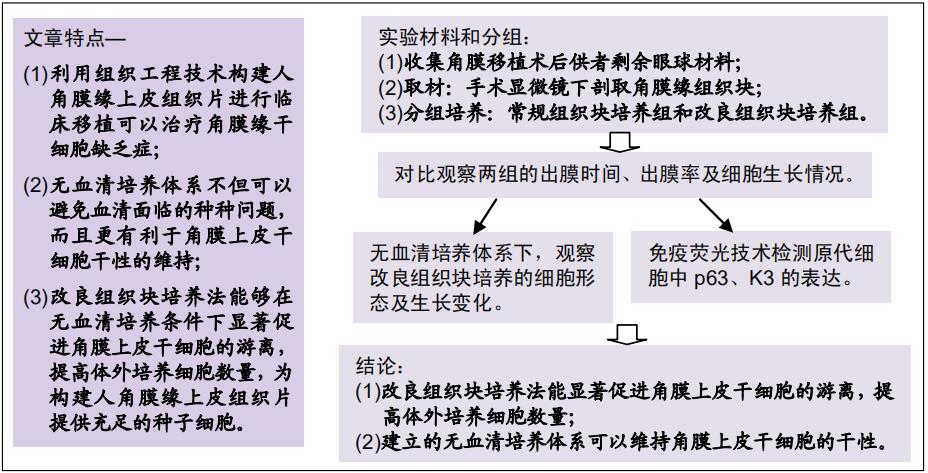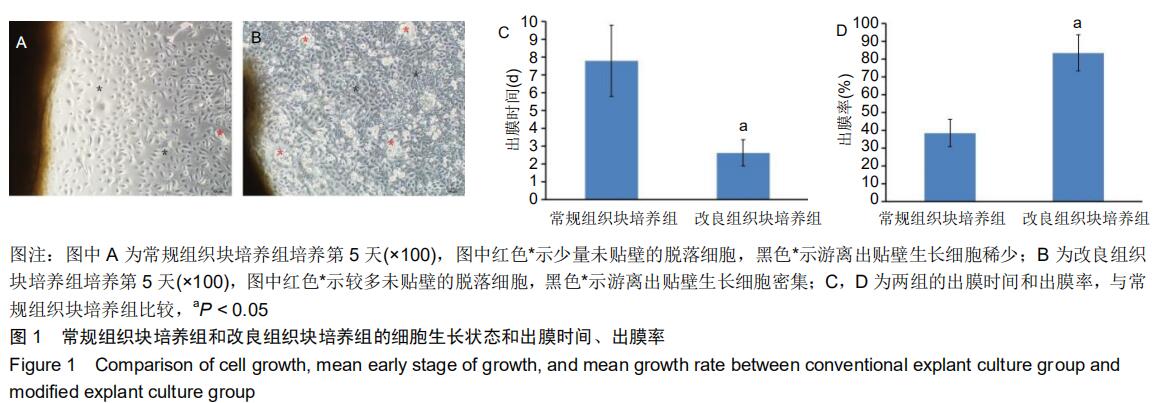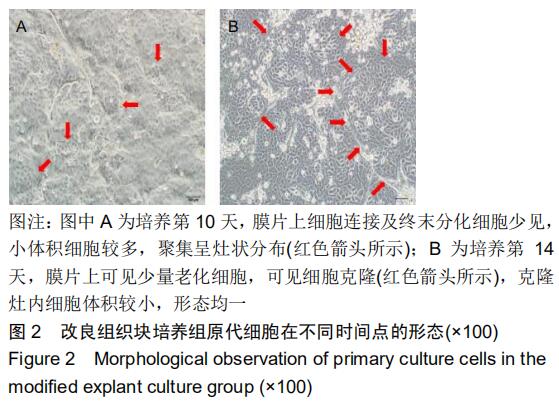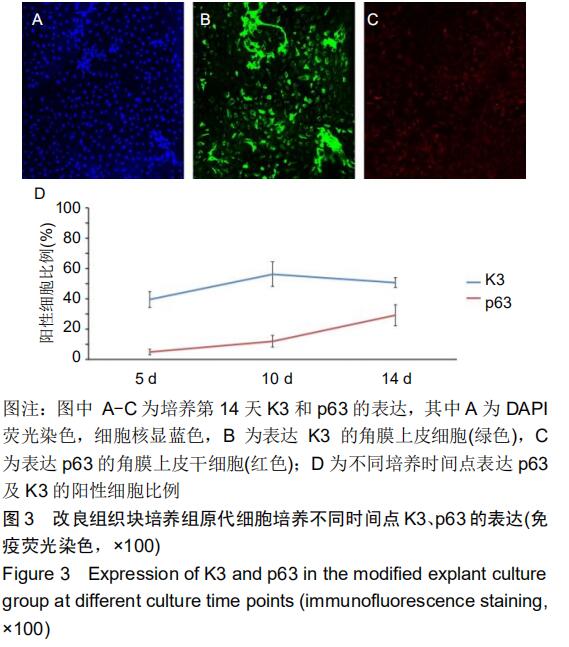|
[1] YAZDANPANAH G, JABBEHDARI S, DJALILIAN AR. Limbal and corneal epithelial homeostasis. Curr Opin Ophthalmol. 2017;28(4):348-354.
[2] YAZDANPANAH G, HAQ Z, KANG K, et al. Strategies for reconstructing the limbal stem cell niche. Ocul Surf. 2019; 17(2):230-240.
[3] DENG SX, BORDERIE V, CHAN CC, et al. Global Consensus on Definition, Classification, Diagnosis, and Staging of Limbal Stem Cell Deficiency. Cornea. 2019;38(3):364-375.
[4] ARAVENA C, BOZKURT K, CHUEPHANICH P, et al. Classification of Limbal Stem Cell Deficiency Using Clinical and Confocal Grading. Cornea. 2019;38(1):1-7.
[5] RAMA P, FERRARI G, PELLEGRINI G. Cultivated limbal epithelial transplantation. Curr Opin Ophthalmol. 2017;28(4): 387-389.
[6] YIN J, JURKUNAS U. Limbal Stem Cell Transplantation and Complications. Semin Ophthalmol. 2018;33(1):134-141.
[7] LÓPEZ-PANIAGUA M, NIETO-MIGUEL T, DE LA MATA A, et al. Comparison of functional limbal epithelial stem cell isolation methods. Exp Eye Res. 2016;146:83-94.
[8] ZHANG ZH, LIU HY, LIU K, et al. Comparison of Explant and Enzyme Digestion Methods for Ex Vivo Isolation of Limbal Epithelial Progenitor Cells. Curr Eye Res. 2016;41(3): 318-325.
[9] LI Y, YANG Y, YANG L, et al. Poly(ethylene glycol)-modified silk fibroin membrane as a carrier for limbal epithelial stem cell transplantation in a rabbit LSCD model. Stem Cell Res Ther. 2017;8(1):256.
[10] LÓPEZ-PANIAGUA M, NIETO-MIGUEL T, DE LA MATA A, et al. Successful Consecutive Expansion of Limbal Explants Using a Biosafe Culture Medium under Feeder Layer-Free Conditions. Curr Eye Res. 2017;42(5):685-695.
[11] UTHEIM OA, PASOVIC L, RAEDER S, et al. Effects of explant size on epithelial outgrowth, thickness, stratification, ultrastructure and phenotype of cultured limbal epithelial cells. PLoS One. 2019;14(3):e0212524.
[12] DERELI CAN G, AKDERE ÖE, CAN ME, et al. A simple and efficient method for cultivation of limbal explant stem cells with clinically safe potential. Cytotherapy. 2019;21(1):83-95.
[13] ZHANG Y, SUN H, LIU Y, et al. The Limbal Epithelial Progenitors in the Limbal Niche Environment. Int J Med Sci. 2016;13(11):835-840.
[14] TSENG SC, HE H, ZHANG S, et al. Niche Regulation of Limbal Epithelial Stem Cells: Relationship between Inflammation and Regeneration. Ocul Surf. 2016;14(2):100-112.
[15] XIE HT, CHEN SY, LI GG, et al. Limbal epithelial stem/progenitor cells attract stromal niche cells by SDF-1/CXCR4 signaling to prevent differentiation. Stem Cells. 2011;29(11):1874-1885.
[16] HAN B, CHEN SY, ZHU YT, et al. Integration of BMP/Wnt signaling to control clonal growth of limbal epithelial progenitor cells by niche cells. Stem Cell Res. 2014;12(2): 562-573.
[17] RAMA P, MATUSKA S, PAGANONI G, et al. Limbal stem-cell therapy and long-term corneal regeneration. N Engl J Med. 2010;363(2):147-155.
[18] LEKHANONT K, CHOUBTUM L, CHUCK RS, et al. A serum- and feeder-free technique of culturing human corneal epithelial stem cells on amniotic membrane. Mol Vis. 2009;15: 1294-1302.
[19] GIAMMARIOLI M, RIDPATH JF, ROSSI E, et al. Genetic detection and characterization of emerging HoBi-like viruses in archival foetal bovine serum batches. Biologicals. 2015; 43(4):220-224.
[20] BREJCHOVA K, TROSAN P, STUDENY P, et al. Characterization and comparison of human limbal explant cultures grown under defined and xeno-free conditions. Exp Eye Res. 2018;176:20-28.
[21] 许中中,余晓菲,杜连心,等.活体及体外条件下对角膜上皮干细胞的定位[J].中国组织工程研究,2014,18(1):94-99.
[22] LI W, HAYASHIDA Y, CHEN YT, et al. Niche regulation of corneal epithelial stem cells at the limbus. Cell Res. 2007; 17(1):26-36.
[23] LIU L, NIELSEN FM, EMMERSEN J, et al. Pigmentation Is Associated with Stemness Hierarchy of Progenitor Cells Within Cultured Limbal Epithelial Cells. Stem Cells. 2018; 36(9):1411-1420.
[24] BOJIC S, HALLAM D, ALCADA N, et al. CD200 Expression Marks a Population of Quiescent Limbal Epithelial Stem Cells with Holoclone Forming Ability. Stem Cells. 2018;36(11): 1723-1735.
[25] GUO ZH, ZHANG W, JIA YYS, et al. An Insight into the Difficulties in the Discovery of Specific Biomarkers of Limbal Stem Cells. Int J Mol Sci. 2018;19(7). pii: E1982.
[26] ESPANA EM, ROMANO AC, KAWAKITA T, et al. Novel enzymatic isolation of an entire viable human limbal epithelial sheet. Invest Ophthalmol Vis Sci. 2003;44(10):4275-4281.
[27] CHEN SY, HAYASHIDA Y, CHEN MY, et al. A new isolation method of human limbal progenitor cells by maintaining close association with their niche cells. Tissue Eng Part C Methods. 2011;17(5):537-548.
[28] DE LA MATA A, MATEOS-TIMONEDA MA, NIETO-MIGUEL T, et al. Poly-l/dl-lactic acid films functionalized with collagen IV as carrier substrata for corneal epithelial stem cells. Colloids Surf B Biointerfaces. 2019;177:121-129.
[29] KIM HS, JUN SONG X, DE PAIVA CS, et al. Phenotypic characterization of human corneal epithelial cells expanded ex vivo from limbal explant and single cell cultures. Exp Eye Res. 2004;79(1):41-49.
[30] LEE HJ, NAM SM, CHOI SK, et al. Comparative study of substrate free and amniotic membrane scaffolds for cultivation of limbal epithelial sheet. Sci Rep. 2018;8(1): 14628.
[31] GÜRDAL M, BARUT SELVER Ö, BAYSAL K, et al. Comparison of culture media indicates a role for autologous serum in enhancing phenotypic preservation of rabbit limbal stem cells in explant culture. Cytotechnology. 2018;70(2): 687-700.
[32] BEHAEGEL J, NÍ DHUBHGHAILL S, KOPPEN C, et al. Safety of Cultivated Limbal Epithelial Stem Cell Transplantation for Human Corneal Regeneration. Stem Cells Int. 2017;2017:6978253.
[33] RIESTRA AC, VAZQUEZ N, CHACON M, et al. Autologous method for ex vivo expansion of human limbal epithelial progenitor cells based on plasma rich in growth factors technology. Ocul Surf. 2017;15(2):248-256.
[34] YAMAGAMI S, YOKOO S, SAKIMOTO T. Ocular Surface Reconstruction with the Autologous Conjunctival Epithelium and Establishment of a Feeder-Free and Serum-Free Culture System. Cornea. 2018;37 Suppl 1:S39-S41.
[35] NAM SM, MAENG YS, KIM EK, et al. Ex Vivo Expansion of Human Limbal Epithelial Cells Using Human Placenta-Derived and Umbilical Cord-Derived Mesenchymal Stem Cells. Stem Cells Int. 2017;2017:4206187.
[36] JOE AW, YEUNG SN. Concise review: identifying limbal stem cells: classical concepts and new challenges. Stem Cells Transl Med. 2014;3(3):318-322.
[37] HUANG M, WANG B, WAN P, et al. Roles of limbal microvascular net and limbal stroma in regulating maintenance of limbal epithelial stem cells. Cell Tissue Res. 2015;359(2):547-563.
[38] ZHANG C, DU L, PANG K, et al. Differentiation of human embryonic stem cells into corneal epithelial progenitor cells under defined conditions. PLoS One. 2017;12(8):e0183303.
[39] SACCHETTI M, RAMA P, BRUSCOLINI A, et al. Limbal Stem Cell Transplantation: Clinical Results, Limits, and Perspectives. Stem Cells Int. 2018;2018:8086269.
[40] SHAYAN ASL N, NEJAT F, MOHAMMADI P, et al. Amniotic Membrane Extract Eye Drop Promotes Limbal Stem Cell Proliferation and Corneal Epithelium Healing. Cell J. 2019; 20(4):459-468.
[41] STADNIKOVA A, TROSAN P, SKALICKA P, et al. Interleukin-13 maintains the stemness of conjunctival epithelial cell cultures prepared from human limbal explants. PLoS One. 2019;14(2):e0211861.
[42] TÓTH E, BEYER D, ZSEBIK B, et al. Limbal and Conjunctival Epithelial Cell Cultivation on Contact Lenses-Different Affixing Techniques and the Effect of Feeder Cells. Eye Contact Lens. 2017;43(3):162-167.
[43] HU L, PU Q, ZHANG Y, et al. Expansion and maintenance of primary corneal epithelial stem/progenitor cells by inhibition of TGFβ receptor I-mediated signaling. Exp Eye Res. 2019;182: 44-56.
[44] KSANDER BR, KOLOVOU PE, WILSON BJ, et al. ABCB5 is a limbal stem cell gene required for corneal development and repair. Nature. 2014;511(7509):353-357.
[45] GONZALEZ G, SASAMOTO Y, KSANDER BR, et al. Limbal stem cells: identity, developmental origin, and therapeutic potential. Wiley Interdiscip Rev Dev Biol. 2018;7(2). doi: 10.1002/wdev.303.
|



